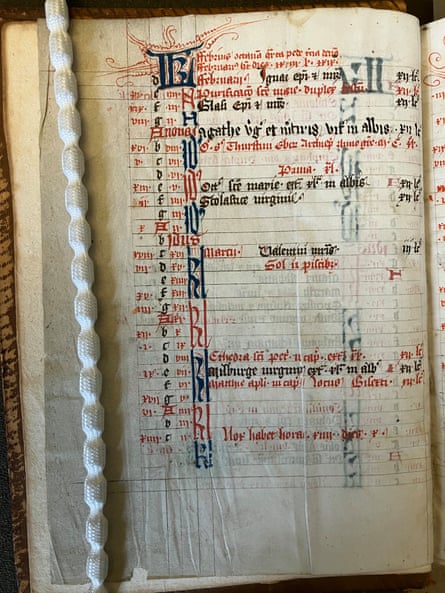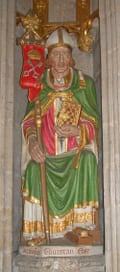‘Unambiguous proof’: medieval archbishop revealed as lost English saint
time:2024-04-28 12:09:54 from:melhor casa de apostasTempos assistidos(143)
- US edition
- UK edition
- Australia edition
- International edition
- Europe edition
- World
- Europe
- US
- Americas
- Asia
- Australia
- Middle East
- Africa
- Inequality
- Global development

‘Unambiguous proof’: medieval archbishop revealed as lost English saint
Historian at English Heritage uncovered entry about Thurstan in a service book from Pontefract Priory, which was laid waste during the Reformation
James TapperSat 3 Feb 2024 08.00 EST
Last modified on Sat 3 Feb 2024 10.43 ESTThurstan was one of medieval England’s most influential figures – archbishop of York, founder of monasteries and defender against invading Scots.
Now English Heritage has uncovered evidence that Thurstan, who was archbishop from 1114 to 1140, is one of England’s lost saints, in a long-overlooked entry in a 15th-century manuscript.
Dr Michael Carter, senior properties historian for English Heritage, made the discovery during research at King’s College, Cambridge, when he was going through a service book from Pontefract Priory.
The book, which the monks used to celebrate Mass, included a calendar of all the saints’ feast days observed at the monastery. “I was doing some research on saints’ relics and looked at this manuscript – it was first day back from a holiday and, boy, did this shake me out of any torpor I might have felt,” Carter said.
There, in the entry for 6 February, was a line in Latin saying “Death of St Thurstan, archbishop of York, year of grace, 1140”, written in red ink – a further sign of its significance.

This proves that three centuries after his death, the monks at Pontefract Priory considered Thurstan to be a saint, Carter said.
England has 173 saints in what the monks at Pontefract would have thought of as “the holy company of heaven”. How could one of them go missing? Henry VIII and Thomas Cromwell have the answer.
“The destruction during the Reformation is extraordinary, especially at monasteries,” Carter said. “It’s estimated that no more than 5% of the material possessions of English medieval churches survive and with monasteries that’s probably well below 1%.”
Pontefract Priory was also a victim of Cromwell’s dissolution of the monasteries. The last prior and monks left in 1539 and nothing now remains.
Yet there is another reason why Thurstan’s sanctity has been overlooked – his decision to go to Pontefract. Thurstan had made a vow as a young man to ally himself to the order of Cluniac monks so, at the age of 70, his health failing, he resigned as archbishop and went to join the order.
“I’ll bet the canons of York Minster were furious that he decided to die in Pontefract,” Carter said. “Canterbury had a host of archbishops buried within its walls. But none at York Minster, and Thurstan was probably the best candidate.” The snub meant his appeal was probably limited to the monks in Pontefract.
Thurstan was born in Normandy in about 1070, the year that William the Conqueror had laid waste to northern England in the so-called harrying of the north, killing tens of thousands of people in what some have described as a genocide.
There’s no doubting he was a great church politician, and he worked his connections, but he was also deeply devout
Thurstan’s father had been a canon at St Paul’s in London and the family returned to England in 1104. Thurstan worked for William II, then his brother Henry I, who decided that his lowly chaplain should become archbishop of York in 1114.
Perhaps Henry had hoped that this rapid elevation would resolve the dispute between York and Canterbury, whose churchmen believed they should be supreme in England. Thurstan disagreed and refused to make a formal profession of obedience to the archbishop of Canterbury. To avoid the king’s fury, he spent the next five years in Europe.
This made Thurstan a “man of European dimensions”, according to Professor Janet Burton, professor of medieval history at the University of Wales Trinity Saint David and a specialist in medieval monastic and religious orders who wrote Thurstan’s entry in the Oxford Dictionary of National Biography.
“Dr Carter’s discovery has added an extra dimension to our understanding of Thurstan’s legacy and his place in the religious culture of the medieval north,” she said.
“Thurstan spent the first five years of his period of office on the continent where he enjoyed contact with popes and cardinals, and the leading lights in new, emergent monastic movements.”

The end of Viking raids and other incursions allowed for greater prosperity across Europe and the birth of the 12th-century renaissance, which saw the flourishing of the universities in Oxford and Cambridge.
On his return to England, Thurstan resolved the dispute with Canterbury, with the help of the Pope, and spent most of his career promoting the foundation of monasteries, including Byland Abbey, Rievaulx Abbey and Kirkham Priory.
After Henry I’s death in 1135, England became embroiled in civil war between Henry’s daughter, Empress Matilda, and his nephew Stephen of Blois. David I of Scotland invaded in 1138 and Thurstan mustered the English army that defeated the Scots at the Battle of the Standard.
“There’s no doubting whatsoever that he was a great church politician, and he worked his connections with the very highest in the land, but he was also deeply, deeply devout,” Carter said.
After his death, the monks at Pontefract established Thurstan’s sanctity by exhuming his body two years later and discovered that it was well-preserved, with an odour of sanctity. He was acclaimed as a saint, Carter said, without any need for the Pope’s approval, a process that was not invented at the time.
“The entry in this manuscript is unambiguous proof that Thurstan was indeed a saint,” Carter said, “and that his name should be seen alongside other religious contemporaries in Northern England, including St William and St Aelred of Rievaulx, St Waldef of Kirkham and Melrose and St Godric of Finchale.”
Anterior:Taxa média de juros tem leve queda em 2023
Próximo:Tory MP walks back comments on First Nations water plant fires
sugestão relacionada
- Saldo de crédito sobe 7,9% no Brasil em 2023, menor alta em 4 anos
- Canadian Paralympians to receive financial reward for medals
- 5 railway stocks jump up to 7% ahead of Union Budget 2024
- Chef David Chang, Chrissy Teigen share best advice for dining out with kids
- Obras na avenida Hélio Prates têm cronograma otimizado para período chuvoso
- ‘Ecumenical catechism’ for public schools in Holy Land a sign of Christian unity
- O novo (e estranho...) nome da AlphaTauri
- Robitussin cough syrup sold nationwide recalled due to contamination
- Los Angeles Police Department has an Asian